A small pest hovers lazily before alighting on the wall in a kitchen environment. What could it be? As difficult as fly identification is, nearly anyone who has worked in pest management would guess that this is a fly in the family Drosophilidae, known more commonly as vinegar or small fruit flies.
These flies are immediately recognizable by professionals as well as the public. If you’ve made food in a kitchen, you’ve seen them. If you’ve been to a bar, you’ve seen plenty!
The more common a pest is, the more names it seems to go by. Vinegar flies are no exception; they also may be called fruit flies, drain gnats, banana flies or pomace flies. Some of these monikers are less accurate and helpful than others, but the group deserves more than one name; our familiarity with them obscures an immense diversity.
Drosophilidae is both common and mysterious. The family displays an astounding range of behaviors, which has allowed some species to become so bizarre that they are rarely viewed by human eyes. Others have become globe-trotting pests that are difficult to control.
Worldwide, Drosophilidae include species that are granivores (on mustard seeds), herbivores (leaf miners), frugivores (look out, raspberries!), predators (mostly on other insects’ eggs and scale insects), commensals (on land crabs and spittle bugs), parasitoids (of true bugs), and kleptoparasites (of Hymenoptera)
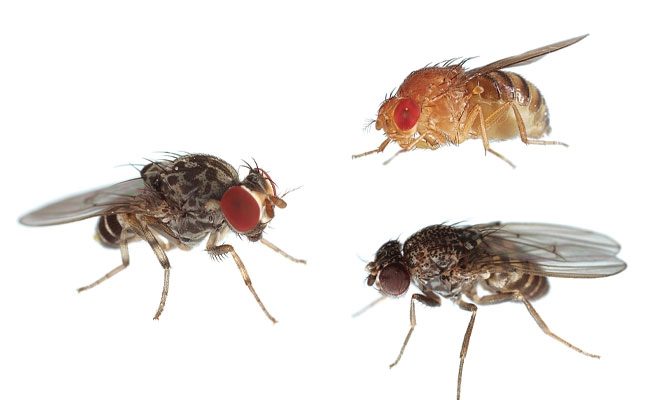
Of course, the most common vinegar flies are good old saprophages, or species that feed on decaying organic matter. Hence, the appropriateness of the moniker “vinegar fly.” As food ferments, it produces alcohol, which is converted by bacteria into acetic acid, aka vinegar. Many of these flies are highly attracted to vinegar, and the areas in which you find the larvae may reek of it (see Fig. 1).
Red-eyed vinegar flies
Residential kitchens with minor sanitation problems and a bowl of fresh produce on the counter are likely to attract red-eyed vinegar flies. This common name may be directed at more than one species; however, a common culprit is Drosophila melanogaster. This is the same species of laboratory experiment stardom, used extensively in studies of genetics and heredity.
The same reason why they are model organisms in the lab makes them difficult to control: a very short life cycle. Egg to adult can happen in about 10 days or, translated into pest management terms, about three life cycles before your next service.
These flies become increasingly common as the summer wears on, and large numbers may invade structures from the outside.
Troubleshooting interior infestations is often straightforward. Inspections should focus on fruits and veggies stored at room temperature, as well as trash cans, beverage container recycling areas, and sinks where food waste is rinsed down the drain.
Like most pest fly issues, finding and removing (cleaning up) these larval habitats is crucial for delivering lasting control. Getting client buy-in often is not difficult for residential clients. Remember, these flies are saprophages, and no self-respecting homeowner wants decaying organic matter — complete with squirming maggots — in their kitchen. Show them some gnarly, wriggling goo and the issue might be resolved before you can get a signature and get out the door.
Commercial environments aren’t spared from red-eyed drosophilids, either. The playbook is largely the same, with inspections expanded to include beer taps, break rooms, trash rooms, food prep areas and mop storage areas, to name a few. Essentially, you are hunting for damp microhabitats where organic matter is just starting to decay (see Fig. 2). Client buy-in to sanitation improvements at commercial establishments may be the harder thing to find.
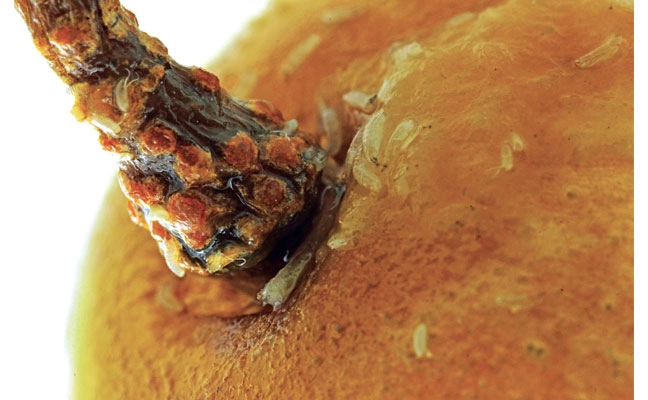
Dark-eyed vinegar flies
Just as there isn’t a single species of red-eyed vinegar fly, the term “dark-eyed” refers to several different species. Sometimes, their eyes aren’t completely dark. They can have a reddish or maroon hue to them, which has been known to confuse even veteran pest management professionals (PMPs). Eye hue alone is not a reliable identification technique (see Fig. 3).
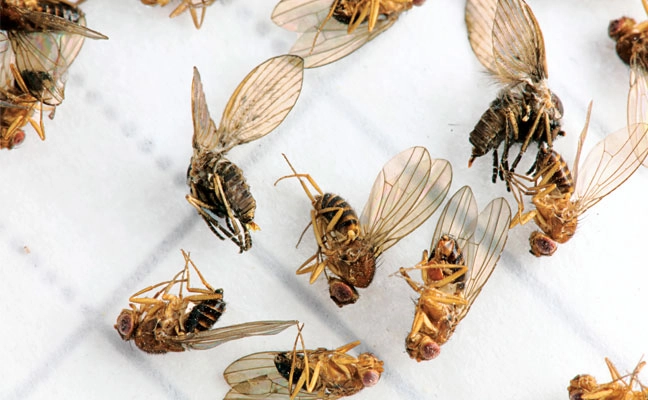
Inquisitive readers may be wondering why we bother to name them after the hue of their eyes, if their eyes aren’t consistently hued? Eye see the confusion. Rest assured, their habits are distinctive and decidedly darker. Call them “dark-dieted vinegar flies” if that floats your boat (or cleans your drain).
Hunting for these flies may feel a bit more like hunting for coffin flies (Phoridae) or drain flies (Psychodidae). Dark-eyed vinegar flies like sludge that is wetter and more decayed than their rosy-eyed counterparts do. The pupae are equipped with long breathing tubes that allow them to pupate in moist muck (see Fig. 4).
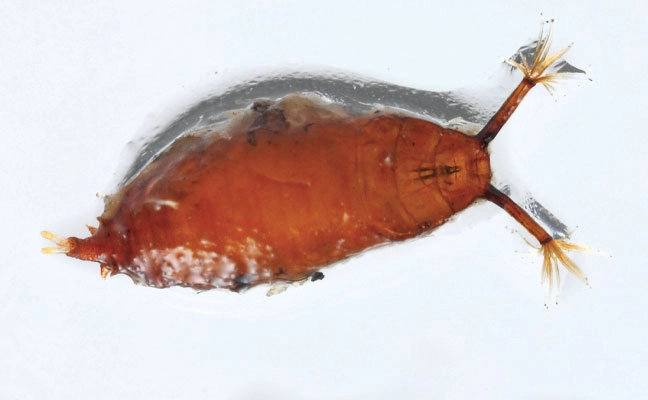
When inspecting for these flies, one must get to the gritty places: floor drains and cracked tiles in dishwashing areas, underneath rubber floor mats in washdown areas, grease traps and yes, even septic lines.
Control strategies
The same principles apply whether dealing with red- or dark-eyed flies, despite the differences in location: Find the source and remove it. That is the playbook, although it’s often easier said than done (see Fig. 5). If the source of the issue can’t be found, cleaned or removed, there are still things to do. Insect light traps (ILTs), baited jar traps and other traps can help reduce the population and monitor progress.
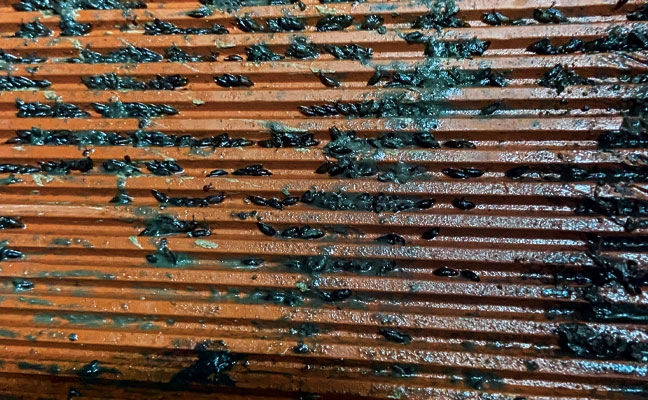
Try some advanced techniques to locate the source, such as using plastic sheeting to divide an area into smaller sections. Apply a fogging agent to kill the adult flies, then come back the next day to reinspect. If only one cordoned-off section has all the flies — the mop closet, for example — all future inspection and remediation efforts can be directly in that zone.
Appropriately labeled spot treatments with a residual or with an insect growth regulator (IGR) often make sense. Remember, many products have additional restrictions when used in food-prep or -handling areas, which is often where these treatments occur (see Fig. 6).
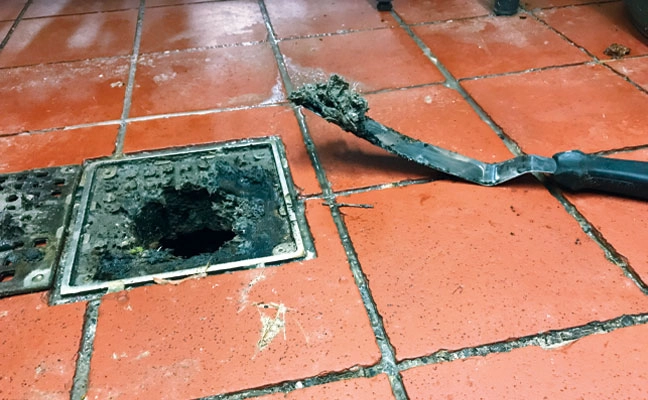
Physical controls, including improved window screens and even fans, vacuum cleaners and steamers, can be used to fight small flies. A note on insect screens, however: Commonly used screen sizes often are inadequate to prevent small drosophilid species from entering.
While attempting to look up the screen mesh size needed to exclude these flies using a trusted reference 2, this author discovered an error instead of an answer: The recommendation of #10 mesh, which are standard screens with 10 wires per inch, will not exclude vinegar flies any more than a fence made out of a single row of hula hoops would prevent a coyote from entering a yard (see Fig. 7).
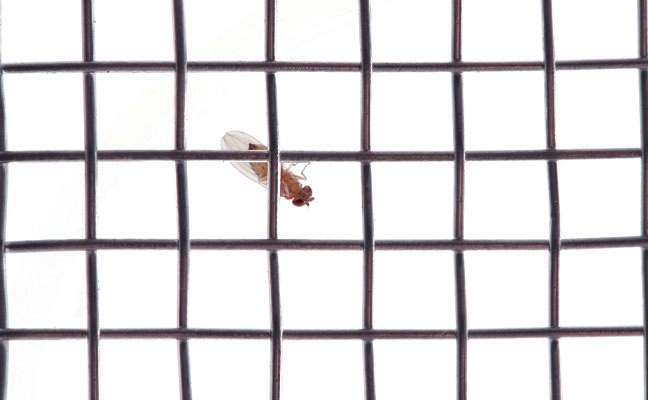
This is a great example of why it’s important to always question things that don’t sound right. Instead, a 20×20 mesh screen, with twice as tight of a weave, is more appropriate if keeping out Drosophila is the primary objective.
A fly in the eye ointment
Just when vinegar flies were beginning to seem manageable, those of us in the Northeast are encountering a species of drosophilid that tosses out all the norms. Careful inspections are not needed to find them; these flies will find you.
On hot summer days near the woods, small “gnats” buzzing around your head may not be the more familiar black flies (Simuliidae) or eye gnats (Chloropidae). Now they may be Phortica variegata, an Old World species of drosophilid that was introduced to North America sometime around 2010. It is established in a handful of Northeastern states. It seems to be widespread in Michigan, despite no other sources reporting it yet.
Pest management professionals (PMPs) are comfortable with the concept of female insects causing more problems than the males (think mosquitoes and stinging hymenopterans). With this species, though, it’s primarily the males that make trouble. Ladies, store this factoid away for the next time someone is leveraging entomology to make sexist comments: These bad boy flies display a behavior known as lachryphagy, or tear eating. They will land on your eyelid and sponge the moisture directly off your eyeball! It’s weird, annoying and fascinating all at once.
Unfortunately, the mucous membranes are a very susceptible location on the human body for pathogens and parasites to enter. These flies are known vectors of the Oriental eyeworm nematode (Thelazia callipaeda), an emergent disease in Europe 3. (Don’t cry about it. That will only encourage them.)
Not much is known about the habits and management of this particular species yet 3, though it can be attracted to some baits and seems to be closely associated with oak forests. One reference reported that large numbers of Phortica could be reared from fallen acorns 4. Have fun with this one, squirrels!
Small fly problems create some of the most frustrating pest management issues. From proper identification to finding the root cause, considering treatment options and getting client cooperation can be challenging.
That’s why it’s always good to improve your knowledge of these insects and bring your A-game. You never know when a desperate client will call about flies in their eyeballs.
VanderWerp is manager of education and training for Rose Pest Solutions, Madison Heights, Mich. He can be reached at PMPEditor@northcoastmedia.net.
References
1. Ashburner, 1981. The Genetics and Biology of Drosophila, Chapter 10 “Entomophagous and Other Bizarre Drosophilidae.”
2. Geiger and Cox, 2012. Pest Prevention by Design: Authoritative Guidelines for Designing Pests Out of Structures.
3. Gonzalez et. al., 2022. Development of Novel Management Tools for Phortica variegata (Diptera: Drosophilidae), Vector of the Oriental Eyeworm, Thelazia callipaeda (Spirurida: Thelaziidae), in Europe.
4. Werner et. al., 2020. The Encyclopedia of North American Drosophilids, Vol. 1: Drosophilids of the Midwest and Northeast.
Leave A Comment